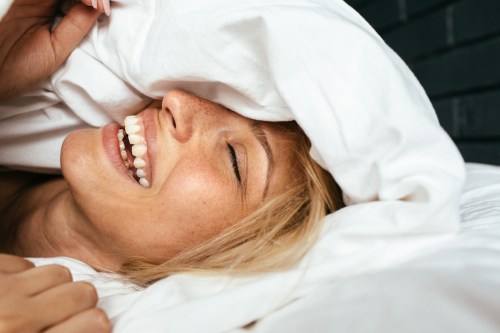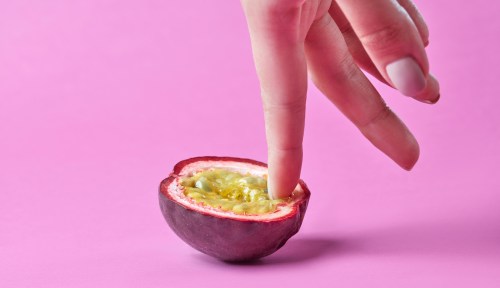Our editors independently select these products. Making a purchase through our links may earn Well+Good a commission
The ‘G-Scale’ Is Like a Richter Scale for Your Orgasms—Here’s How To Use It
The G-Scale for orgasms is a new online tool to help you understand the magnitude of your pleasure. Here's what to know about it.

It’s no secret that not every orgasm is created equally. Whether marked by a slow, steady wave that pulses gently across your pelvic floor or a the full-blown, leg-shaking burst of pleasure that stands to take your breath away, the sensation of orgasm can vary each and every time a vulva owner experiences one. Sometimes, they leave us feeling euphoric and satisfied, while other times, they leave us wanting more.
Experts in This Article
licensed psychotherapist, cognitive neuroscientist, and certified sex therapist
If you’ve ever wondered why some big Os might be more substantial than others, or you simply want to take your climax to new heights, there’s a new, science-backed scale that may help you understand exactly how to do it. Pleasure-toy brand Hot Octopuss recently released its “G-Scale,” which is essentially a Richter scale for your orgasms. Created in partnership with Nan Wise, PhD, a neuroscientist and sex therapist, the G-Scale, which takes the form of an online questionnaire, aims to help vulva owners, “expand, elevate, and embrace a wider spectrum of sexual pleasure.”
The tool’s methodology for identifying the quaking magnitude of your orgasms is simple: We all have different erogenous zones. The clitoris is a popular one, but it’s not the only one—the vagina, G-spot, cervix, and nipples can also factor in to how we get off. “When you stimulate various parts of the genitals, you can activate a place in the brain called the genital sensory cortex, or what we like to call, ‘the Brain Crotch,’” says Dr. Wise. “Think of it as playing more keys on the pleasure piano. When you add different keys, you can get a better range of sensations and a better experience.”
Below, learn how the G-Scale for orgasms can help you measure how each erogenous zone piques your genital sensory cortex, and, in turn, pleasure magnitude.
How the G-Scale for orgasms works
While the Richter scale measures the strength of earthquakes, the G-Scale for orgasms measures the magnitude of pleasure that vulva-owners experience.
Orgasm magnitudes are ranked on a scale of one to six based on erogenous-zone stimulation. A magnitude of one is achieved strictly through clitoral stimulation, which results in those low, tingly orgasms that sit in and around the genitals and pelvic floor. As erogenous zones are added, like deep penetration and nipple play, the orgasms climb in power on the G-Scale. Six—or “G+” as it’s labeled on the G-Scale—is the strongest climax, which is achieved by stimulating a combination of the clitoris, vagina, G-spot, nipples and the mind. It’s also referred to as the ‘M-Zone,’ because it includes a powerful not-so-secret ingredient of mindfulness for the highest level of pleasure.
“[Vulva-owners] can tune up the volume on their sensory experiences just by turning their attention to it. That ‘M-Zone,’ as we like to call it, is the highest zone that adds everything together.” —Nan Wise, PhD
According to Dr. Wise, this last component of mindfulness can seriously amplify the level of pleasure we feel. She’s found in her research that just thinking about sex can light our brains up and turn us on. And when we’re actually having partnered sex or enjoying a solo sesh, being present and focusing on those sensations is key to achieving a fuller, more satisfying climax. “[Vulva-owners] can turn up the volume on their sensory experiences just by turning their attention to it,” she says. “That ‘M-Zone,’ as we like to call it, is the highest zone that adds everything together.”
So, how do you figure out where you fall on the G-Scale? It’s pretty easy. Your magnitude is generated via an interactive quiz that walks you through a set of questions about your sex life, like how often you masturbate, have partnered sex, and achieve orgasm. Some questions are more involved, though, like “How often do you or your partner attempt to stimulate your G-spot during sex or masturbation?” Once you submit, you’ll receive your results via email.
How to level up your orgasm magnitude if you don’t like your G-Scale quiz results:
So, let’s say you took the G-Scale quiz and now you want to raise the magnitude of your pleasure. First things first, know that, according to Dr. Wise, getting off is not the end game for your pleasure, and the G-Scale is best used to help you tune into your sensation and better understand your body. Basically, use the G-Scale to better understand what feels good for you. Then, if you do want to expand your orgasms, try a few of the following ideas:
1. Experiment with different erogenous zones
If your orgasms land at a magnitude of 1 or 2, chances are, you enjoy clitoral stimulation. While it can feel fantastic, know that arousing other hot spots, like the vulva, G-spot, and even the cervix, can as well—so try those!
Dr. Wise suggests suggests practicing stimulating the G-spot with a toy by pushing it up against the front wall of the vagina. If that’s not doing it for you, expand clitoral stimulation by pressing down on the clitoris or massaging the inner lips of your vulva with your fingers. “Go in, and get curious and explorative about sensation.”
2. Lift and strengthen the pelvic floor
“Your pelvic floor really strengthens blood flow and the wiring of the nervous system,” says Dr. Wise. “Pelvic floor strength is huge for orgasmic capacity.”
So, try and increase your pelvic-floor strength by flexing your kegels during penetration or using a toy as a pelvic floor exerciser by intentionally pulling it in and pushing it out without using your hands. Or experiment with pelvic placement: How does it feel when you rock your hips rhythmically to your partner during partnered penetrative sex? How does sensation change if you masturbate with your hips tilted up? Get creative with how you use your pelvis.
3. Target that “M-Zone”
The mind-body connection is vital in achieving that all-consuming, euphoric G+ orgasm, and one way to access it through breathwork. “That’s the way our bodies go into the receptive state that allows us to be present,” says Dr. Wise. She suggests focusing on taking long, smooth inhales paired with relaxing exhales to encourage mindfulness.
And again, lean into feeling pleasure for the sake of feeling pleasure. “Healthy hedonism feels good and is good for us,” says Dr. Wise. “Exploring our capacity for our bodies to experience pleasure isn’t a luxury. It’s really important for our bodies to be well-balanced.”
Oh hi! You look like someone who loves free workouts, discounts for cult-fave wellness brands, and exclusive Well+Good content. Sign up for Well+, our online community of wellness insiders, and unlock your rewards instantly.
Sign Up for Our Daily Newsletter
Get all the latest in wellness, trends, food, fitness, beauty, and more delivered right to your inbox.
Got it, you've been added to our email list.










